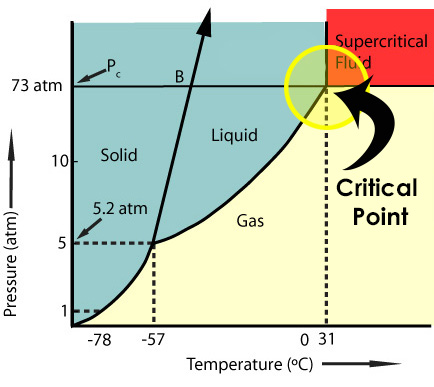What Is Supercritical CO2?
Carbon dioxide is in its supercritical fluid state when both the temperature and pressure equal or exceed the critical point of 31°C and 73 atm (see diagram). In its supercritical state, CO2 has both gas-like and liquid-like qualities, and it is this dual characteristic of supercritical fluids that provides the ideal conditions for extracting compounds with a high degree of recovery in a short period of time.
By controlling or regulating pressure and temperature, the density, or solvent strength, of supercritical fluids can be altered to simulate organic solvents ranging from chloroform to methylene chloride to hexane. This dissolving power can be applied to purify, extract, fractionate, infuse, and recrystallize a wide array of materials.
Because CO2 is non-polar, a polar organic co-solvent (or modifier) can be added to the supercritical fluid for processing polar compounds. By controlling the level of pressure/temperature/modifier, supercritical CO2 can dissolve a broad range of compounds, both polar and non-polar.
The most commonly used gas is carbon dioxide.

Why do you need to know about Supercritical Fluids
It's the Environment! It's Nanotechnology! It's NOW!
- Global Warming
- Disposal
- Consumer Health
- Worker Health
- New techniques of solvating - no surface tension
- Endless Applications in the Real World!
It's Easy Being Green!
Carbon dioxide is one of the most commonly used supercritical fluids.
CO2 is:
- Safe
- Inexpensive
- Readily available
- An ideal substitute for many hazardous and toxic solvents
- CO2 is not produced in the SCF process.
- Existing CO2 is merely used.
- There is NO addition to any greenhouse effect.
SCF is NOW!